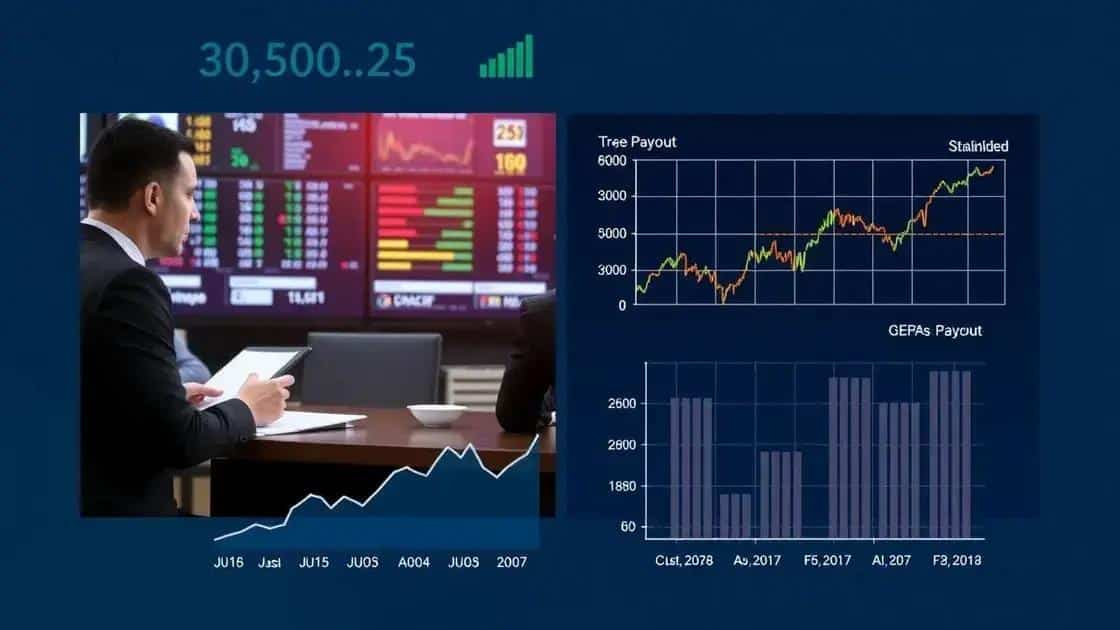New rules for corporate buybacks and shareholder payouts

The new rules for corporate buybacks and shareholder payouts enhance transparency and accountability, fostering sustainable growth while balancing investor returns with the need for long-term corporate investments.
New rules for corporate buybacks and shareholder payouts are reshaping how companies manage their finances. Have you considered how these changes could impact your investments? Let’s dive into what this means for you.
Understanding the new rules for corporate buybacks
Understanding the new rules for corporate buybacks is crucial for both companies and investors. These regulations can impact how businesses allocate their resources.
What are Corporate Buybacks?
Corporate buybacks occur when a company repurchases its own shares. This action can boost the stock price and return value to shareholders. It can also signal confidence in the company’s future.
Key Changes in Regulations
The new rules introduce a more structured approach to corporate buybacks. Companies must now disclose more information regarding their buyback intentions, making the process more transparent for investors.
- Enhanced disclosure requirements
- Limitations on the timing of buybacks
- New thresholds for approvals
These changes aim to prevent companies from making decisions that may artificially inflate stock prices without underlying performance improvements. The transparency ensures that shareholders understand the reasons behind buyback decisions.
An important part of this shift is addressing the balance between rewarding shareholders and investing in business growth. The new rules encourage companies to prioritize long-term success over short-term price boosts.
Impacts on Investors
For investors, these regulations can bring both benefits and challenges. With clearer information, investors can make more informed decisions regarding their investments.
- Better understanding of company strategies
- Increased accountability from companies
- Potential for improved long-term growth
Though the new rules may limit some buyback activities, they also promote a healthier corporate environment where decisions are made with greater scrutiny.
Impact of shareholder payouts on market dynamics

The impact of shareholder payouts on market dynamics can be significant, affecting not just the companies involved but also the broader financial landscape. When companies distribute profits to shareholders, it can lead to various changes in market behavior.
Understanding Shareholder Payouts
Shareholder payouts typically come in two forms: dividends and stock buybacks. Dividends provide direct cash payments to investors, while buybacks reduce the total number of shares, potentially increasing the stock price. Both methods signal a company’s commitment to returning value to its investors.
Market Reactions to Payouts
When companies announce payouts, market reactions can be swift and varied. Investors often interpret these announcements as positive indicators of a company’s health and future prospects.
- Increased investor confidence
- Short-term stock price spikes
- Long-term investment strategies may shift
As more companies engage in shareholder payouts, it can reshape market dynamics. The demand for stocks may rise, pushing prices higher. This increased interest can lead to a more competitive atmosphere among companies striving to attract investors.
However, if a company’s focus shifts heavily towards payouts at the expense of growth investment, this can raise concerns. Analysts may question the sustainability of such strategies over the long haul. A balance must be struck between rewarding shareholders and investing in future growth.
Effects on Company Strategy
Companies must consider how their payout strategies influence their overall market position. The impact of shareholder payouts extends beyond immediate financial returns; it also shapes public perception and long-term strategy.
- Payouts can enhance brand reputation
- Influence on executive compensation decisions
- Possible reduction in capital for reinvestment
Ultimately, while maintaining shareholder satisfaction is vital, companies should remain vigilant about ensuring their strategies foster long-term sustainability and growth.
Analyzing the benefits for investors and companies
Analyzing the benefits for investors and companies regarding the new rules for corporate buybacks and shareholder payouts reveals interesting insights. Both parties stand to gain significantly from these regulations, which promote transparency and accountability.
Benefits for Investors
For investors, the changes create a clearer picture of a company’s financial strategy. With greater transparency, shareholders can better understand how their investment is being managed. This understanding can lead to enhanced trust in the company’s management.
- Increased visibility into payout decisions
- Better alignment of shareholder and company interests
- Potential for more sustainable growth
With the new rules, investors are likely to feel more secure knowing that companies are being held accountable for their financial strategies. This heightened accountability can encourage investors to remain engaged with companies as they seek long-term value.
Benefits for Companies
Companies also benefit from adhering to the updated regulations. By engaging in responsible buybacks and payouts, they can enhance their reputations in the market. This can lead to a stronger brand image and improved investor confidence.
- Enhanced corporate reputation
- Attraction of new investors
- Positive impact on stock prices over time
The focus on doing what is best for shareholders can also lead to better overall business performance. When companies prioritize transparency, they may find it easier to attract talent and build partnerships, knowing that they operate with integrity.
In summary, the benefits for investors and companies under the new rules create a more balanced and sustainable financial environment. Both parties can find common ground in their objectives, leading to overall market improvements.
Future implications of buyback regulations

The future implications of buyback regulations are set to reshape the investment landscape significantly. As companies adapt to these new guidelines, both their strategies and market dynamics will evolve.
Long-Term Effects on Corporate Behavior
With increased transparency expected from the new rules, companies might adopt more prudent financial practices. By focusing on sustainable growth, firms can balance rewarding shareholders with investing in future opportunities.
- Increased fiduciary responsibility to shareholders
- Greater emphasis on long-term performance over short-term gains
- Potential reduction in speculative trading
These changes will likely foster a business environment where long-term strategies are valued, potentially leading to healthier companies and more stable markets.
Market Adaptations
Investors will need to adapt to a landscape where buyback motivations are more transparent. As companies follow the new rules, investor strategies may also change in response.
- Increased focus on fundamental analysis
- Shift towards stocks with sustainable growth potential
- More scrutiny on corporate decision-making
Investors will be better equipped to evaluate a company’s health based on its adherence to these regulations, promoting a market that rewards accountability.
Potential Challenges
While increased regulations can promote stability, they may also present challenges. Companies could face pressure to balance shareholder demands with the need for reinvestment.
If firms prioritize buybacks excessively, it might hinder their ability to innovate or expand. Thus, striking the right balance will be critical for success in a regulated environment.
Overall, the future implications of buyback regulations are multifaceted. Both opportunities and challenges lie ahead, shaping how companies and investors navigate the financial landscape.
In conclusion, the new rules for corporate buybacks and shareholder payouts present both challenges and opportunities for companies and investors alike. By emphasizing transparency and accountability, these regulations can lead to healthier financial practices that benefit everyone involved. As businesses adapt to these changes, they will likely focus on long-term growth while balancing the needs of their shareholders. Understanding these implications is essential for navigating the evolving market landscape.
\n\n
\n
FAQ – Frequently Asked Questions about Corporate Buybacks and Shareholder Payouts
What are corporate buybacks?
Corporate buybacks occur when a company repurchases its own shares from the market, which can help increase the stock price by reducing the number of shares available.
How do shareholder payouts impact investors?
Shareholder payouts, such as dividends and buybacks, provide direct returns to investors, increasing their confidence in the company’s financial health.
What are the new rules for corporate buybacks?
The new rules require companies to disclose more information about their buyback strategies and ensure that these actions do not compromise long-term growth.
Why is transparency important in buybacks?
Transparency allows investors to understand the motivations behind buybacks, promoting trust and enabling better investment decisions.





